Investigating Employee Retention Strategies at British Petroleum, UK
VerifiedAdded on 2023/04/06
|42
|6850
|126
Report
AI Summary
This research report investigates employee retention strategies at British Petroleum (BP) in the UK, aiming to identify how the organization retains its key employees amidst a dynamic market environment. A primary data analysis was conducted through a survey of approximately 30 BP employees using a non-probability sampling method. The findings emphasize the critical importance of employee retention in a rapidly changing business landscape, highlighting the increasing tendency of employees to seek better opportunities elsewhere. The study explores factors influencing retention, including employee engagement, job satisfaction, skill recognition, training, career development, compensation, and leadership. The report concludes with recommendations for BP to enhance its retention strategies, focusing on creating a supportive and rewarding work environment to foster employee loyalty and reduce turnover. Desklib provides access to this and many other solved assignments for students.
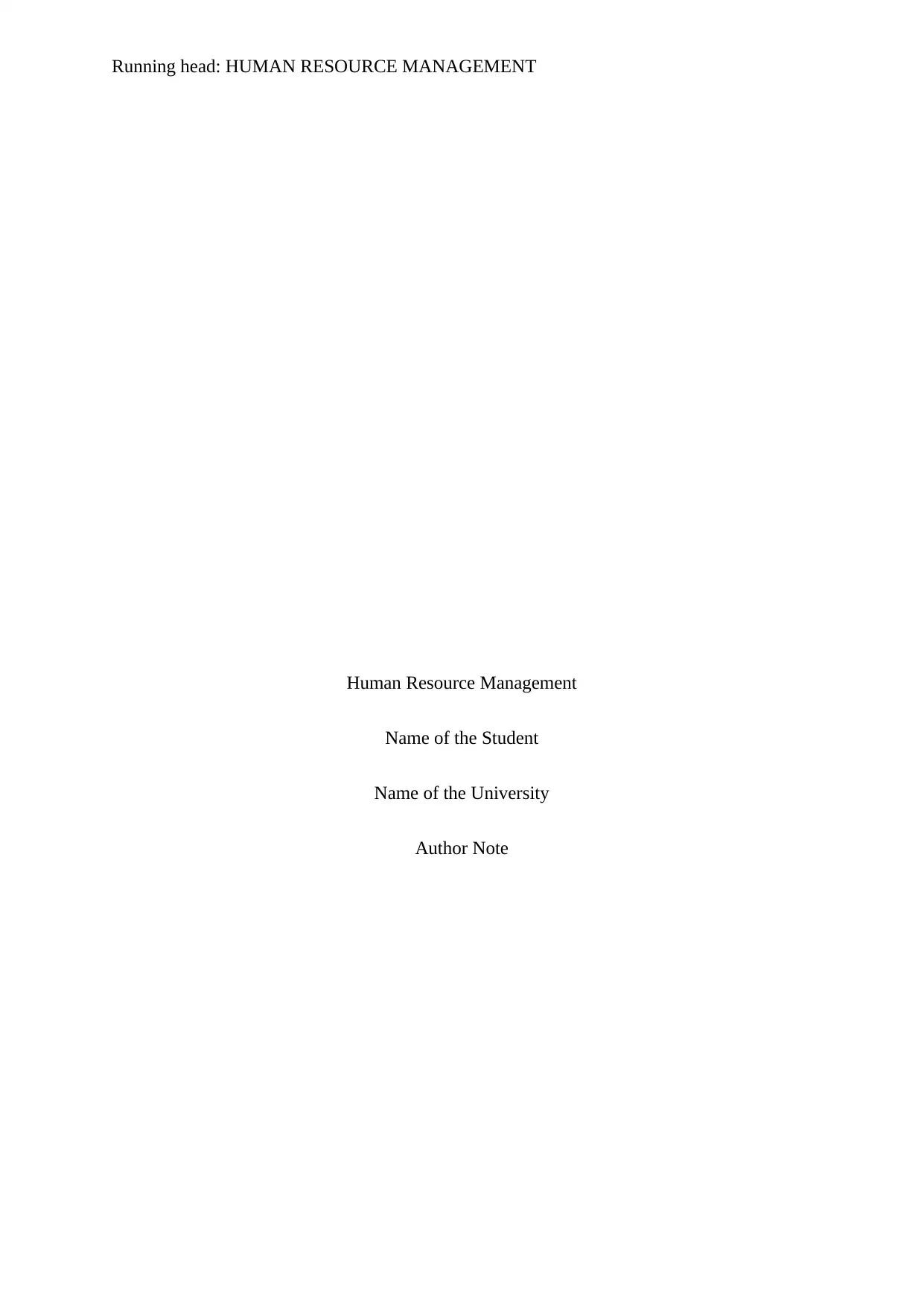
Running head: HUMAN RESOURCE MANAGEMENT
Human Resource Management
Name of the Student
Name of the University
Author Note
Human Resource Management
Name of the Student
Name of the University
Author Note
Paraphrase This Document
Need a fresh take? Get an instant paraphrase of this document with our AI Paraphraser
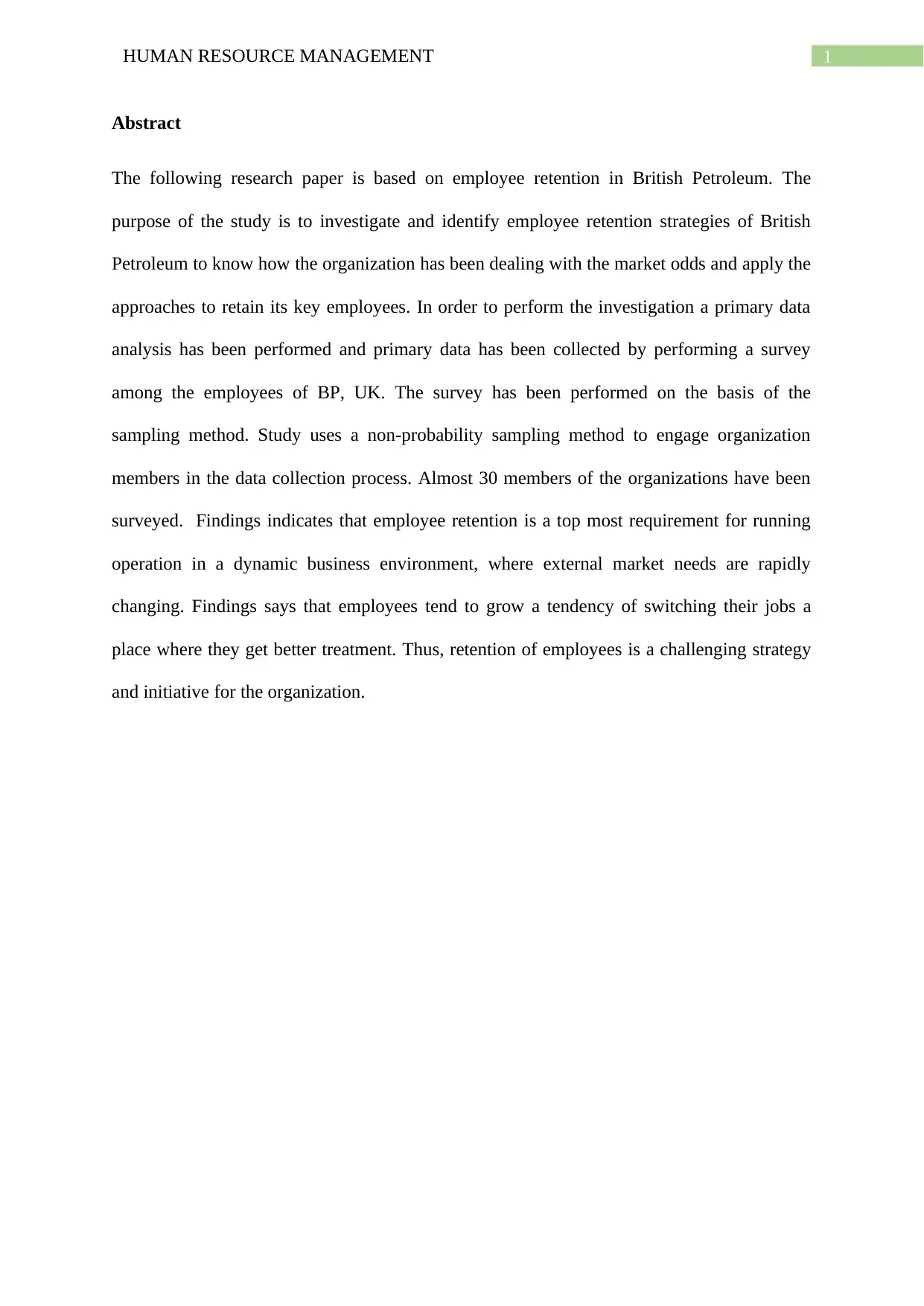
1HUMAN RESOURCE MANAGEMENT
Abstract
The following research paper is based on employee retention in British Petroleum. The
purpose of the study is to investigate and identify employee retention strategies of British
Petroleum to know how the organization has been dealing with the market odds and apply the
approaches to retain its key employees. In order to perform the investigation a primary data
analysis has been performed and primary data has been collected by performing a survey
among the employees of BP, UK. The survey has been performed on the basis of the
sampling method. Study uses a non-probability sampling method to engage organization
members in the data collection process. Almost 30 members of the organizations have been
surveyed. Findings indicates that employee retention is a top most requirement for running
operation in a dynamic business environment, where external market needs are rapidly
changing. Findings says that employees tend to grow a tendency of switching their jobs a
place where they get better treatment. Thus, retention of employees is a challenging strategy
and initiative for the organization.
Abstract
The following research paper is based on employee retention in British Petroleum. The
purpose of the study is to investigate and identify employee retention strategies of British
Petroleum to know how the organization has been dealing with the market odds and apply the
approaches to retain its key employees. In order to perform the investigation a primary data
analysis has been performed and primary data has been collected by performing a survey
among the employees of BP, UK. The survey has been performed on the basis of the
sampling method. Study uses a non-probability sampling method to engage organization
members in the data collection process. Almost 30 members of the organizations have been
surveyed. Findings indicates that employee retention is a top most requirement for running
operation in a dynamic business environment, where external market needs are rapidly
changing. Findings says that employees tend to grow a tendency of switching their jobs a
place where they get better treatment. Thus, retention of employees is a challenging strategy
and initiative for the organization.
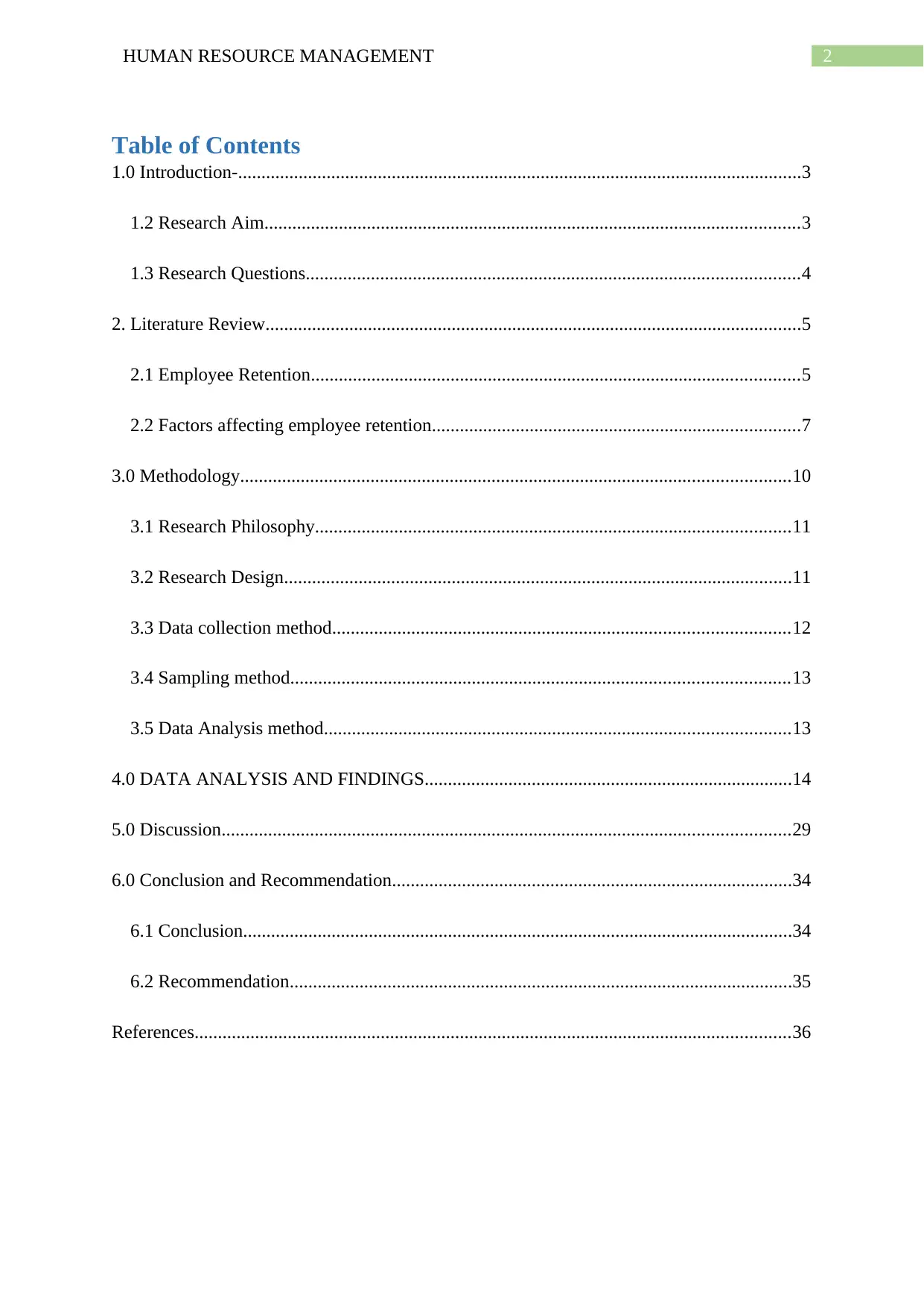
2HUMAN RESOURCE MANAGEMENT
Table of Contents
1.0 Introduction-.........................................................................................................................3
1.2 Research Aim...................................................................................................................3
1.3 Research Questions..........................................................................................................4
2. Literature Review...................................................................................................................5
2.1 Employee Retention.........................................................................................................5
2.2 Factors affecting employee retention...............................................................................7
3.0 Methodology......................................................................................................................10
3.1 Research Philosophy......................................................................................................11
3.2 Research Design.............................................................................................................11
3.3 Data collection method..................................................................................................12
3.4 Sampling method...........................................................................................................13
3.5 Data Analysis method....................................................................................................13
4.0 DATA ANALYSIS AND FINDINGS...............................................................................14
5.0 Discussion..........................................................................................................................29
6.0 Conclusion and Recommendation......................................................................................34
6.1 Conclusion......................................................................................................................34
6.2 Recommendation............................................................................................................35
References................................................................................................................................36
Table of Contents
1.0 Introduction-.........................................................................................................................3
1.2 Research Aim...................................................................................................................3
1.3 Research Questions..........................................................................................................4
2. Literature Review...................................................................................................................5
2.1 Employee Retention.........................................................................................................5
2.2 Factors affecting employee retention...............................................................................7
3.0 Methodology......................................................................................................................10
3.1 Research Philosophy......................................................................................................11
3.2 Research Design.............................................................................................................11
3.3 Data collection method..................................................................................................12
3.4 Sampling method...........................................................................................................13
3.5 Data Analysis method....................................................................................................13
4.0 DATA ANALYSIS AND FINDINGS...............................................................................14
5.0 Discussion..........................................................................................................................29
6.0 Conclusion and Recommendation......................................................................................34
6.1 Conclusion......................................................................................................................34
6.2 Recommendation............................................................................................................35
References................................................................................................................................36
⊘ This is a preview!⊘
Do you want full access?
Subscribe today to unlock all pages.

Trusted by 1+ million students worldwide
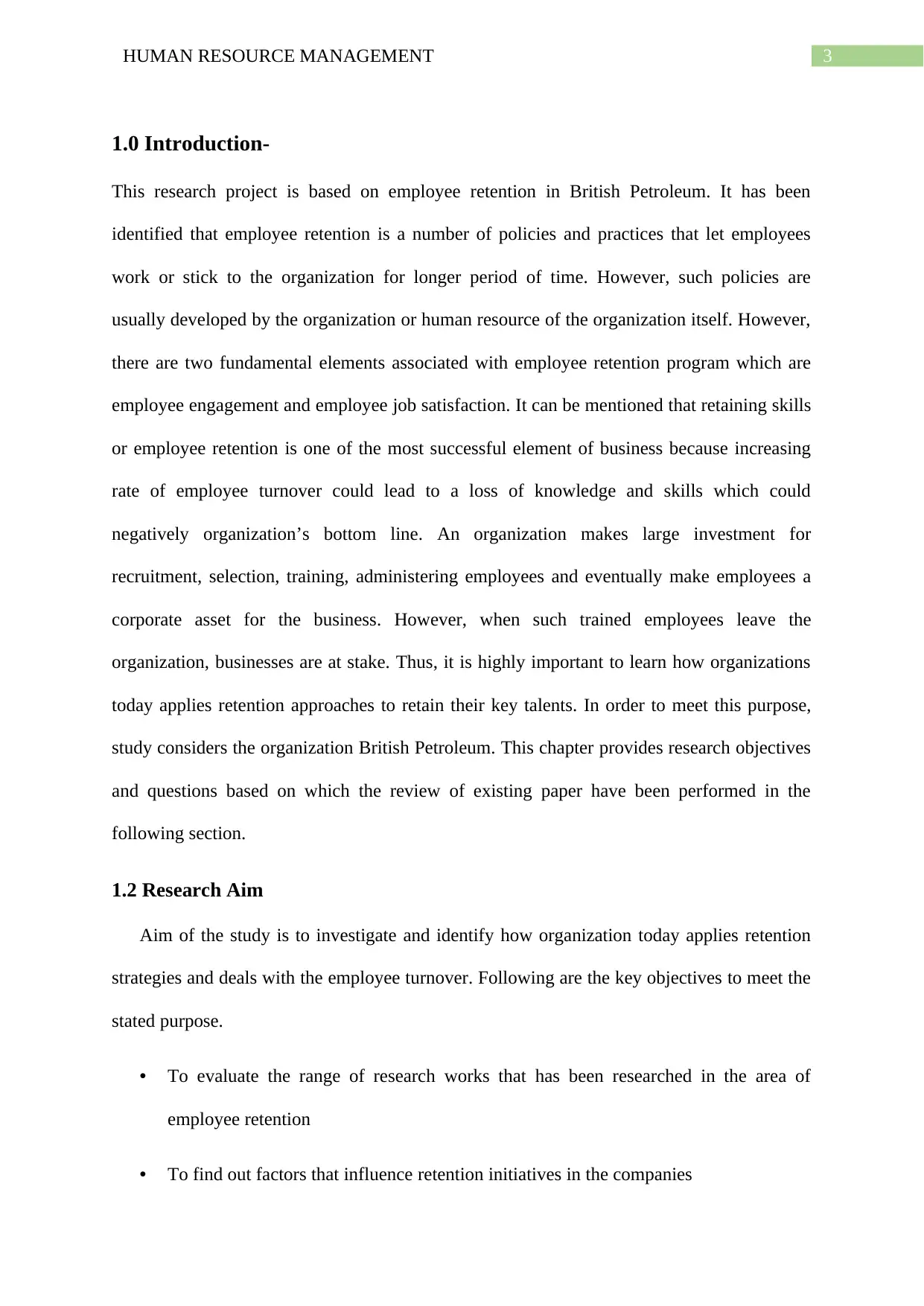
3HUMAN RESOURCE MANAGEMENT
1.0 Introduction-
This research project is based on employee retention in British Petroleum. It has been
identified that employee retention is a number of policies and practices that let employees
work or stick to the organization for longer period of time. However, such policies are
usually developed by the organization or human resource of the organization itself. However,
there are two fundamental elements associated with employee retention program which are
employee engagement and employee job satisfaction. It can be mentioned that retaining skills
or employee retention is one of the most successful element of business because increasing
rate of employee turnover could lead to a loss of knowledge and skills which could
negatively organization’s bottom line. An organization makes large investment for
recruitment, selection, training, administering employees and eventually make employees a
corporate asset for the business. However, when such trained employees leave the
organization, businesses are at stake. Thus, it is highly important to learn how organizations
today applies retention approaches to retain their key talents. In order to meet this purpose,
study considers the organization British Petroleum. This chapter provides research objectives
and questions based on which the review of existing paper have been performed in the
following section.
1.2 Research Aim
Aim of the study is to investigate and identify how organization today applies retention
strategies and deals with the employee turnover. Following are the key objectives to meet the
stated purpose.
• To evaluate the range of research works that has been researched in the area of
employee retention
• To find out factors that influence retention initiatives in the companies
1.0 Introduction-
This research project is based on employee retention in British Petroleum. It has been
identified that employee retention is a number of policies and practices that let employees
work or stick to the organization for longer period of time. However, such policies are
usually developed by the organization or human resource of the organization itself. However,
there are two fundamental elements associated with employee retention program which are
employee engagement and employee job satisfaction. It can be mentioned that retaining skills
or employee retention is one of the most successful element of business because increasing
rate of employee turnover could lead to a loss of knowledge and skills which could
negatively organization’s bottom line. An organization makes large investment for
recruitment, selection, training, administering employees and eventually make employees a
corporate asset for the business. However, when such trained employees leave the
organization, businesses are at stake. Thus, it is highly important to learn how organizations
today applies retention approaches to retain their key talents. In order to meet this purpose,
study considers the organization British Petroleum. This chapter provides research objectives
and questions based on which the review of existing paper have been performed in the
following section.
1.2 Research Aim
Aim of the study is to investigate and identify how organization today applies retention
strategies and deals with the employee turnover. Following are the key objectives to meet the
stated purpose.
• To evaluate the range of research works that has been researched in the area of
employee retention
• To find out factors that influence retention initiatives in the companies
Paraphrase This Document
Need a fresh take? Get an instant paraphrase of this document with our AI Paraphraser
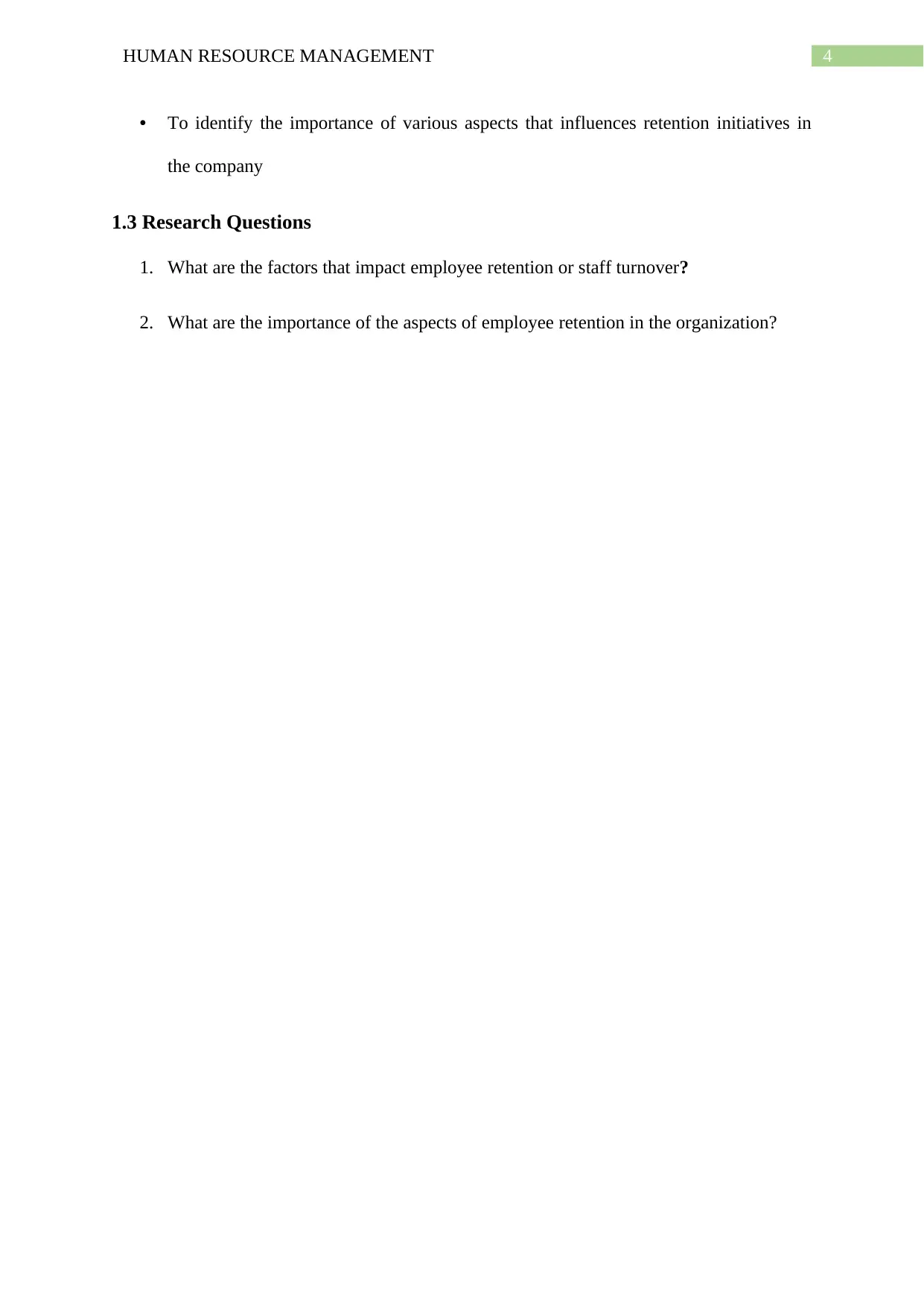
4HUMAN RESOURCE MANAGEMENT
• To identify the importance of various aspects that influences retention initiatives in
the company
1.3 Research Questions
1. What are the factors that impact employee retention or staff turnover?
2. What are the importance of the aspects of employee retention in the organization?
• To identify the importance of various aspects that influences retention initiatives in
the company
1.3 Research Questions
1. What are the factors that impact employee retention or staff turnover?
2. What are the importance of the aspects of employee retention in the organization?
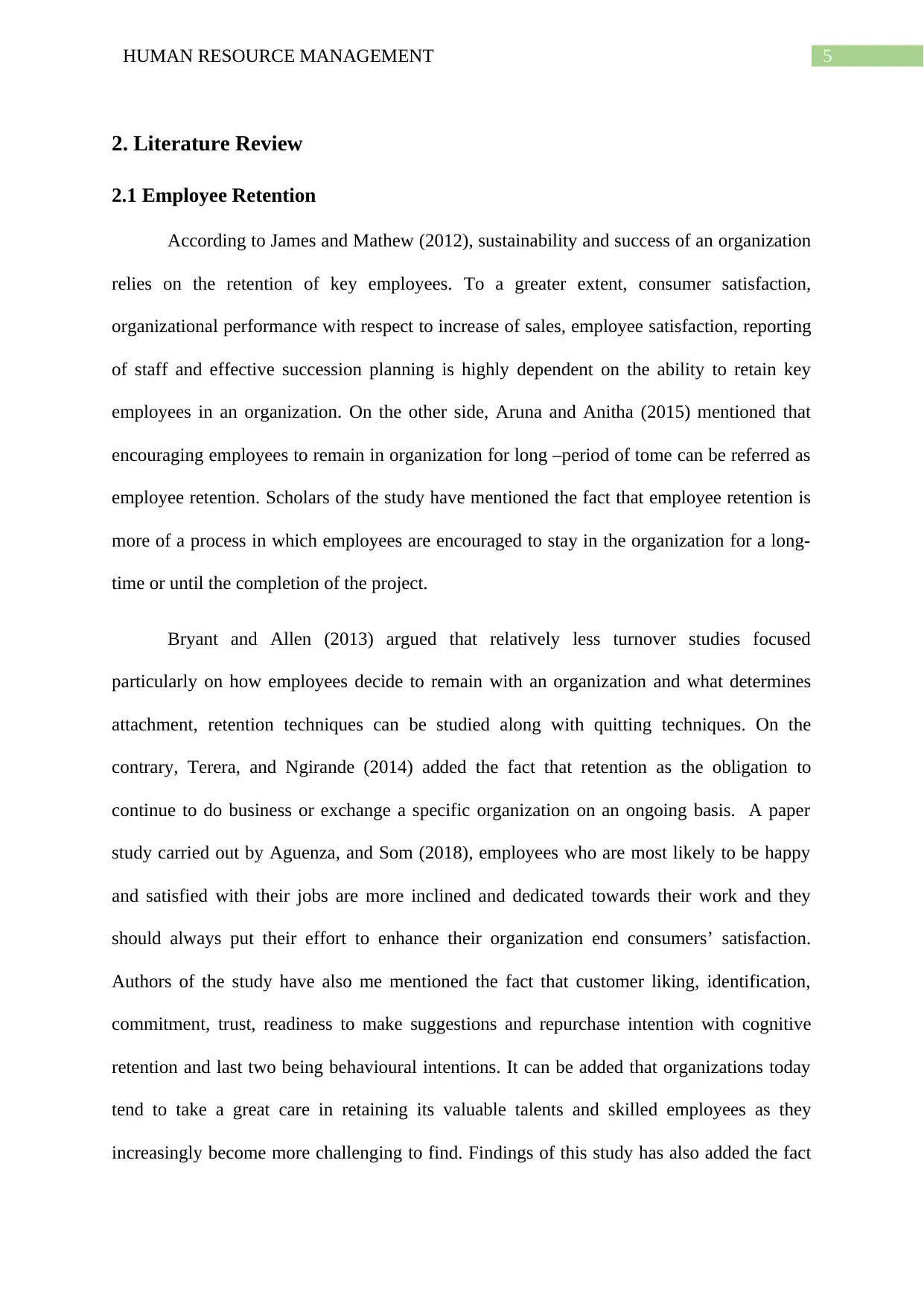
5HUMAN RESOURCE MANAGEMENT
2. Literature Review
2.1 Employee Retention
According to James and Mathew (2012), sustainability and success of an organization
relies on the retention of key employees. To a greater extent, consumer satisfaction,
organizational performance with respect to increase of sales, employee satisfaction, reporting
of staff and effective succession planning is highly dependent on the ability to retain key
employees in an organization. On the other side, Aruna and Anitha (2015) mentioned that
encouraging employees to remain in organization for long –period of tome can be referred as
employee retention. Scholars of the study have mentioned the fact that employee retention is
more of a process in which employees are encouraged to stay in the organization for a long-
time or until the completion of the project.
Bryant and Allen (2013) argued that relatively less turnover studies focused
particularly on how employees decide to remain with an organization and what determines
attachment, retention techniques can be studied along with quitting techniques. On the
contrary, Terera, and Ngirande (2014) added the fact that retention as the obligation to
continue to do business or exchange a specific organization on an ongoing basis. A paper
study carried out by Aguenza, and Som (2018), employees who are most likely to be happy
and satisfied with their jobs are more inclined and dedicated towards their work and they
should always put their effort to enhance their organization end consumers’ satisfaction.
Authors of the study have also me mentioned the fact that customer liking, identification,
commitment, trust, readiness to make suggestions and repurchase intention with cognitive
retention and last two being behavioural intentions. It can be added that organizations today
tend to take a great care in retaining its valuable talents and skilled employees as they
increasingly become more challenging to find. Findings of this study has also added the fact
2. Literature Review
2.1 Employee Retention
According to James and Mathew (2012), sustainability and success of an organization
relies on the retention of key employees. To a greater extent, consumer satisfaction,
organizational performance with respect to increase of sales, employee satisfaction, reporting
of staff and effective succession planning is highly dependent on the ability to retain key
employees in an organization. On the other side, Aruna and Anitha (2015) mentioned that
encouraging employees to remain in organization for long –period of tome can be referred as
employee retention. Scholars of the study have mentioned the fact that employee retention is
more of a process in which employees are encouraged to stay in the organization for a long-
time or until the completion of the project.
Bryant and Allen (2013) argued that relatively less turnover studies focused
particularly on how employees decide to remain with an organization and what determines
attachment, retention techniques can be studied along with quitting techniques. On the
contrary, Terera, and Ngirande (2014) added the fact that retention as the obligation to
continue to do business or exchange a specific organization on an ongoing basis. A paper
study carried out by Aguenza, and Som (2018), employees who are most likely to be happy
and satisfied with their jobs are more inclined and dedicated towards their work and they
should always put their effort to enhance their organization end consumers’ satisfaction.
Authors of the study have also me mentioned the fact that customer liking, identification,
commitment, trust, readiness to make suggestions and repurchase intention with cognitive
retention and last two being behavioural intentions. It can be added that organizations today
tend to take a great care in retaining its valuable talents and skilled employees as they
increasingly become more challenging to find. Findings of this study has also added the fact
⊘ This is a preview!⊘
Do you want full access?
Subscribe today to unlock all pages.

Trusted by 1+ million students worldwide
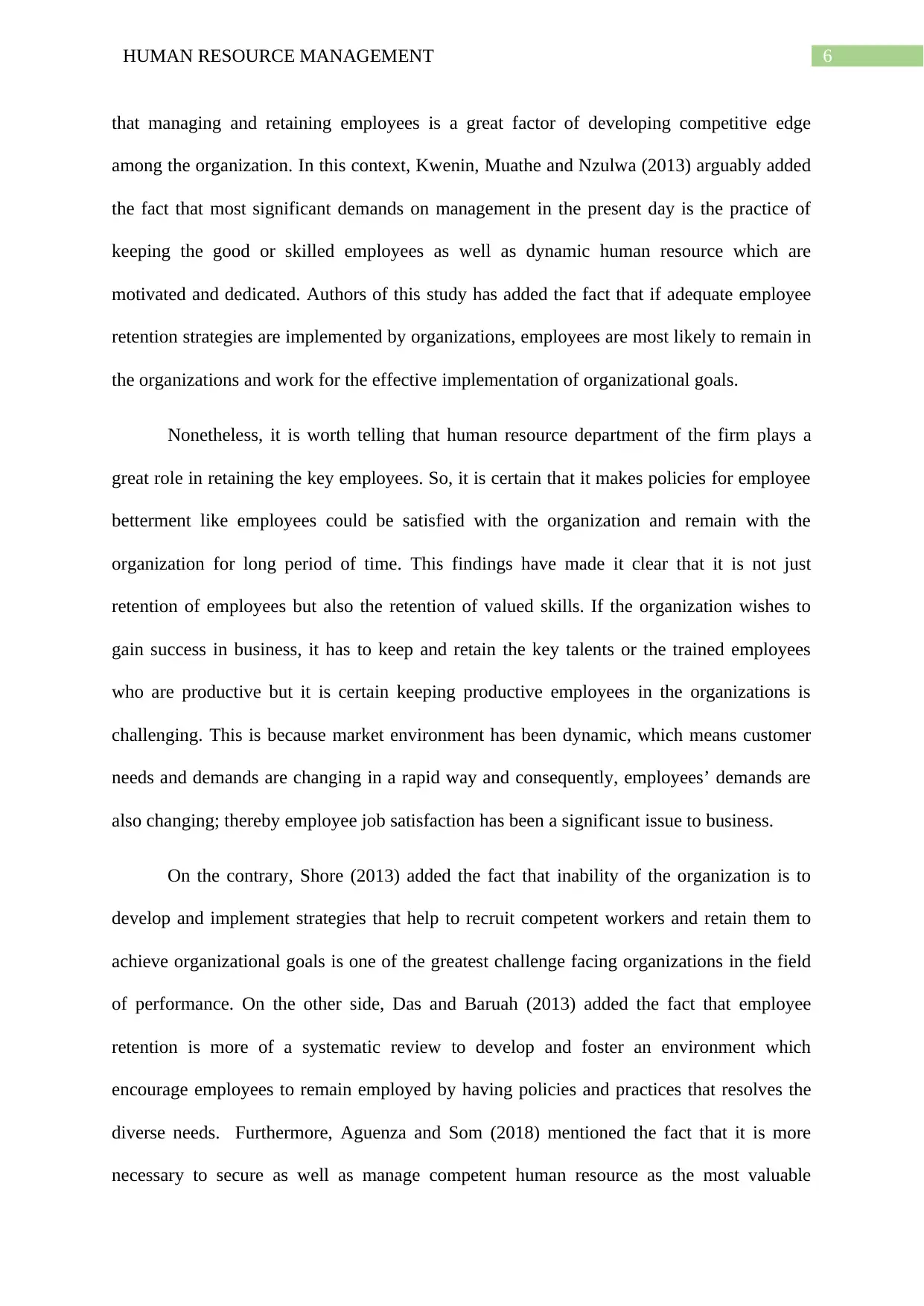
6HUMAN RESOURCE MANAGEMENT
that managing and retaining employees is a great factor of developing competitive edge
among the organization. In this context, Kwenin, Muathe and Nzulwa (2013) arguably added
the fact that most significant demands on management in the present day is the practice of
keeping the good or skilled employees as well as dynamic human resource which are
motivated and dedicated. Authors of this study has added the fact that if adequate employee
retention strategies are implemented by organizations, employees are most likely to remain in
the organizations and work for the effective implementation of organizational goals.
Nonetheless, it is worth telling that human resource department of the firm plays a
great role in retaining the key employees. So, it is certain that it makes policies for employee
betterment like employees could be satisfied with the organization and remain with the
organization for long period of time. This findings have made it clear that it is not just
retention of employees but also the retention of valued skills. If the organization wishes to
gain success in business, it has to keep and retain the key talents or the trained employees
who are productive but it is certain keeping productive employees in the organizations is
challenging. This is because market environment has been dynamic, which means customer
needs and demands are changing in a rapid way and consequently, employees’ demands are
also changing; thereby employee job satisfaction has been a significant issue to business.
On the contrary, Shore (2013) added the fact that inability of the organization is to
develop and implement strategies that help to recruit competent workers and retain them to
achieve organizational goals is one of the greatest challenge facing organizations in the field
of performance. On the other side, Das and Baruah (2013) added the fact that employee
retention is more of a systematic review to develop and foster an environment which
encourage employees to remain employed by having policies and practices that resolves the
diverse needs. Furthermore, Aguenza and Som (2018) mentioned the fact that it is more
necessary to secure as well as manage competent human resource as the most valuable
that managing and retaining employees is a great factor of developing competitive edge
among the organization. In this context, Kwenin, Muathe and Nzulwa (2013) arguably added
the fact that most significant demands on management in the present day is the practice of
keeping the good or skilled employees as well as dynamic human resource which are
motivated and dedicated. Authors of this study has added the fact that if adequate employee
retention strategies are implemented by organizations, employees are most likely to remain in
the organizations and work for the effective implementation of organizational goals.
Nonetheless, it is worth telling that human resource department of the firm plays a
great role in retaining the key employees. So, it is certain that it makes policies for employee
betterment like employees could be satisfied with the organization and remain with the
organization for long period of time. This findings have made it clear that it is not just
retention of employees but also the retention of valued skills. If the organization wishes to
gain success in business, it has to keep and retain the key talents or the trained employees
who are productive but it is certain keeping productive employees in the organizations is
challenging. This is because market environment has been dynamic, which means customer
needs and demands are changing in a rapid way and consequently, employees’ demands are
also changing; thereby employee job satisfaction has been a significant issue to business.
On the contrary, Shore (2013) added the fact that inability of the organization is to
develop and implement strategies that help to recruit competent workers and retain them to
achieve organizational goals is one of the greatest challenge facing organizations in the field
of performance. On the other side, Das and Baruah (2013) added the fact that employee
retention is more of a systematic review to develop and foster an environment which
encourage employees to remain employed by having policies and practices that resolves the
diverse needs. Furthermore, Aguenza and Som (2018) mentioned the fact that it is more
necessary to secure as well as manage competent human resource as the most valuable
Paraphrase This Document
Need a fresh take? Get an instant paraphrase of this document with our AI Paraphraser
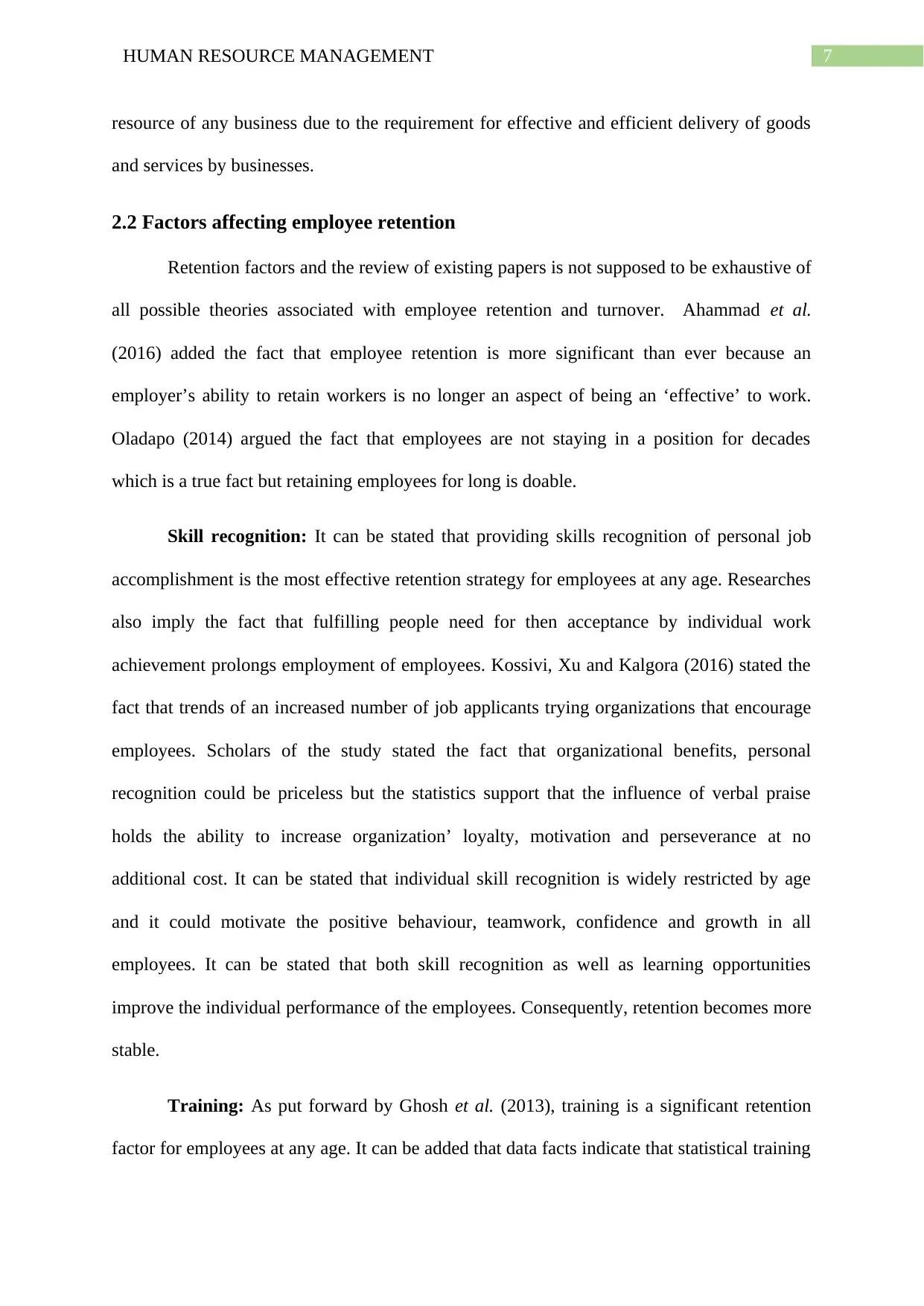
7HUMAN RESOURCE MANAGEMENT
resource of any business due to the requirement for effective and efficient delivery of goods
and services by businesses.
2.2 Factors affecting employee retention
Retention factors and the review of existing papers is not supposed to be exhaustive of
all possible theories associated with employee retention and turnover. Ahammad et al.
(2016) added the fact that employee retention is more significant than ever because an
employer’s ability to retain workers is no longer an aspect of being an ‘effective’ to work.
Oladapo (2014) argued the fact that employees are not staying in a position for decades
which is a true fact but retaining employees for long is doable.
Skill recognition: It can be stated that providing skills recognition of personal job
accomplishment is the most effective retention strategy for employees at any age. Researches
also imply the fact that fulfilling people need for then acceptance by individual work
achievement prolongs employment of employees. Kossivi, Xu and Kalgora (2016) stated the
fact that trends of an increased number of job applicants trying organizations that encourage
employees. Scholars of the study stated the fact that organizational benefits, personal
recognition could be priceless but the statistics support that the influence of verbal praise
holds the ability to increase organization’ loyalty, motivation and perseverance at no
additional cost. It can be stated that individual skill recognition is widely restricted by age
and it could motivate the positive behaviour, teamwork, confidence and growth in all
employees. It can be stated that both skill recognition as well as learning opportunities
improve the individual performance of the employees. Consequently, retention becomes more
stable.
Training: As put forward by Ghosh et al. (2013), training is a significant retention
factor for employees at any age. It can be added that data facts indicate that statistical training
resource of any business due to the requirement for effective and efficient delivery of goods
and services by businesses.
2.2 Factors affecting employee retention
Retention factors and the review of existing papers is not supposed to be exhaustive of
all possible theories associated with employee retention and turnover. Ahammad et al.
(2016) added the fact that employee retention is more significant than ever because an
employer’s ability to retain workers is no longer an aspect of being an ‘effective’ to work.
Oladapo (2014) argued the fact that employees are not staying in a position for decades
which is a true fact but retaining employees for long is doable.
Skill recognition: It can be stated that providing skills recognition of personal job
accomplishment is the most effective retention strategy for employees at any age. Researches
also imply the fact that fulfilling people need for then acceptance by individual work
achievement prolongs employment of employees. Kossivi, Xu and Kalgora (2016) stated the
fact that trends of an increased number of job applicants trying organizations that encourage
employees. Scholars of the study stated the fact that organizational benefits, personal
recognition could be priceless but the statistics support that the influence of verbal praise
holds the ability to increase organization’ loyalty, motivation and perseverance at no
additional cost. It can be stated that individual skill recognition is widely restricted by age
and it could motivate the positive behaviour, teamwork, confidence and growth in all
employees. It can be stated that both skill recognition as well as learning opportunities
improve the individual performance of the employees. Consequently, retention becomes more
stable.
Training: As put forward by Ghosh et al. (2013), training is a significant retention
factor for employees at any age. It can be added that data facts indicate that statistical training
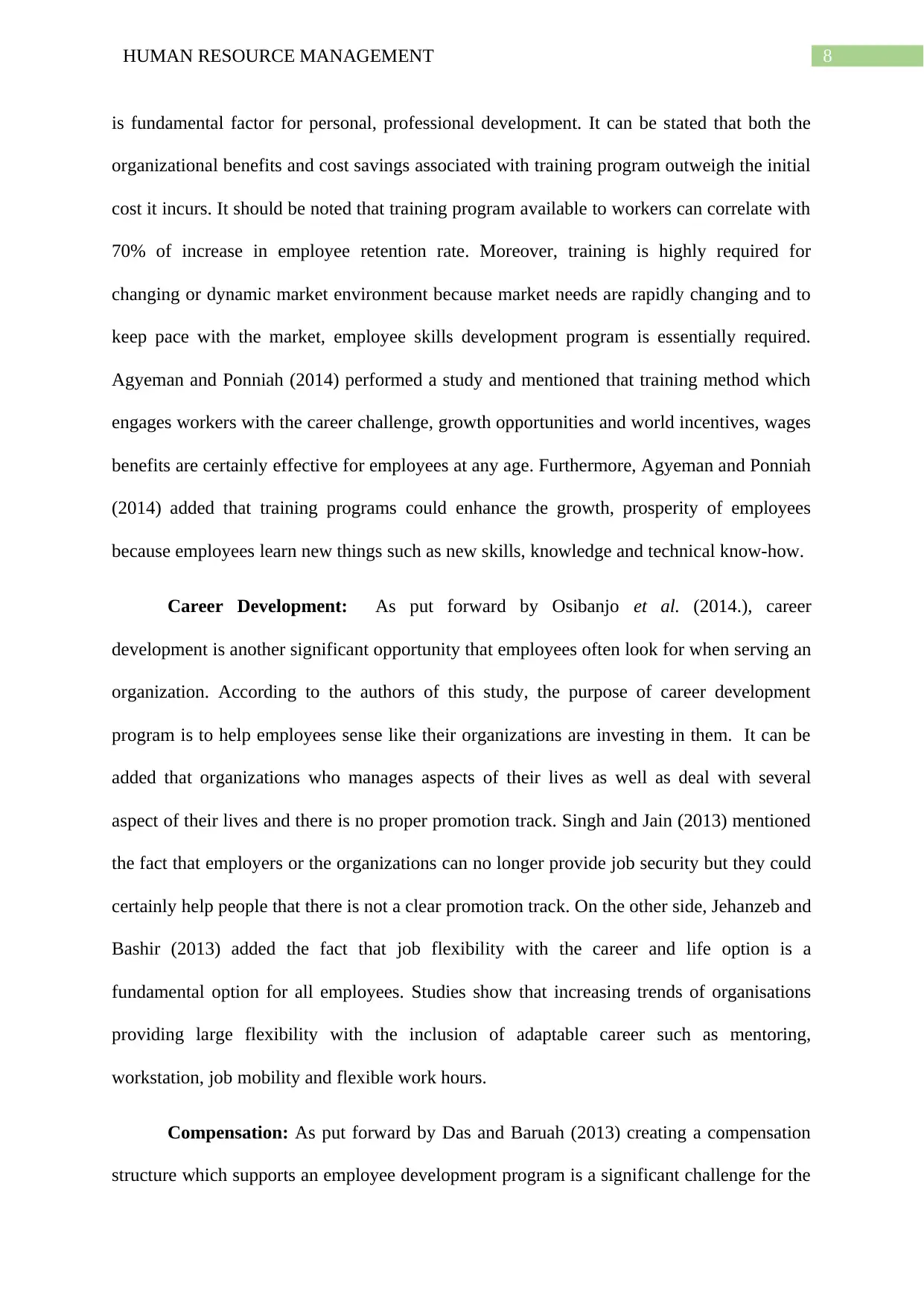
8HUMAN RESOURCE MANAGEMENT
is fundamental factor for personal, professional development. It can be stated that both the
organizational benefits and cost savings associated with training program outweigh the initial
cost it incurs. It should be noted that training program available to workers can correlate with
70% of increase in employee retention rate. Moreover, training is highly required for
changing or dynamic market environment because market needs are rapidly changing and to
keep pace with the market, employee skills development program is essentially required.
Agyeman and Ponniah (2014) performed a study and mentioned that training method which
engages workers with the career challenge, growth opportunities and world incentives, wages
benefits are certainly effective for employees at any age. Furthermore, Agyeman and Ponniah
(2014) added that training programs could enhance the growth, prosperity of employees
because employees learn new things such as new skills, knowledge and technical know-how.
Career Development: As put forward by Osibanjo et al. (2014.), career
development is another significant opportunity that employees often look for when serving an
organization. According to the authors of this study, the purpose of career development
program is to help employees sense like their organizations are investing in them. It can be
added that organizations who manages aspects of their lives as well as deal with several
aspect of their lives and there is no proper promotion track. Singh and Jain (2013) mentioned
the fact that employers or the organizations can no longer provide job security but they could
certainly help people that there is not a clear promotion track. On the other side, Jehanzeb and
Bashir (2013) added the fact that job flexibility with the career and life option is a
fundamental option for all employees. Studies show that increasing trends of organisations
providing large flexibility with the inclusion of adaptable career such as mentoring,
workstation, job mobility and flexible work hours.
Compensation: As put forward by Das and Baruah (2013) creating a compensation
structure which supports an employee development program is a significant challenge for the
is fundamental factor for personal, professional development. It can be stated that both the
organizational benefits and cost savings associated with training program outweigh the initial
cost it incurs. It should be noted that training program available to workers can correlate with
70% of increase in employee retention rate. Moreover, training is highly required for
changing or dynamic market environment because market needs are rapidly changing and to
keep pace with the market, employee skills development program is essentially required.
Agyeman and Ponniah (2014) performed a study and mentioned that training method which
engages workers with the career challenge, growth opportunities and world incentives, wages
benefits are certainly effective for employees at any age. Furthermore, Agyeman and Ponniah
(2014) added that training programs could enhance the growth, prosperity of employees
because employees learn new things such as new skills, knowledge and technical know-how.
Career Development: As put forward by Osibanjo et al. (2014.), career
development is another significant opportunity that employees often look for when serving an
organization. According to the authors of this study, the purpose of career development
program is to help employees sense like their organizations are investing in them. It can be
added that organizations who manages aspects of their lives as well as deal with several
aspect of their lives and there is no proper promotion track. Singh and Jain (2013) mentioned
the fact that employers or the organizations can no longer provide job security but they could
certainly help people that there is not a clear promotion track. On the other side, Jehanzeb and
Bashir (2013) added the fact that job flexibility with the career and life option is a
fundamental option for all employees. Studies show that increasing trends of organisations
providing large flexibility with the inclusion of adaptable career such as mentoring,
workstation, job mobility and flexible work hours.
Compensation: As put forward by Das and Baruah (2013) creating a compensation
structure which supports an employee development program is a significant challenge for the
⊘ This is a preview!⊘
Do you want full access?
Subscribe today to unlock all pages.

Trusted by 1+ million students worldwide
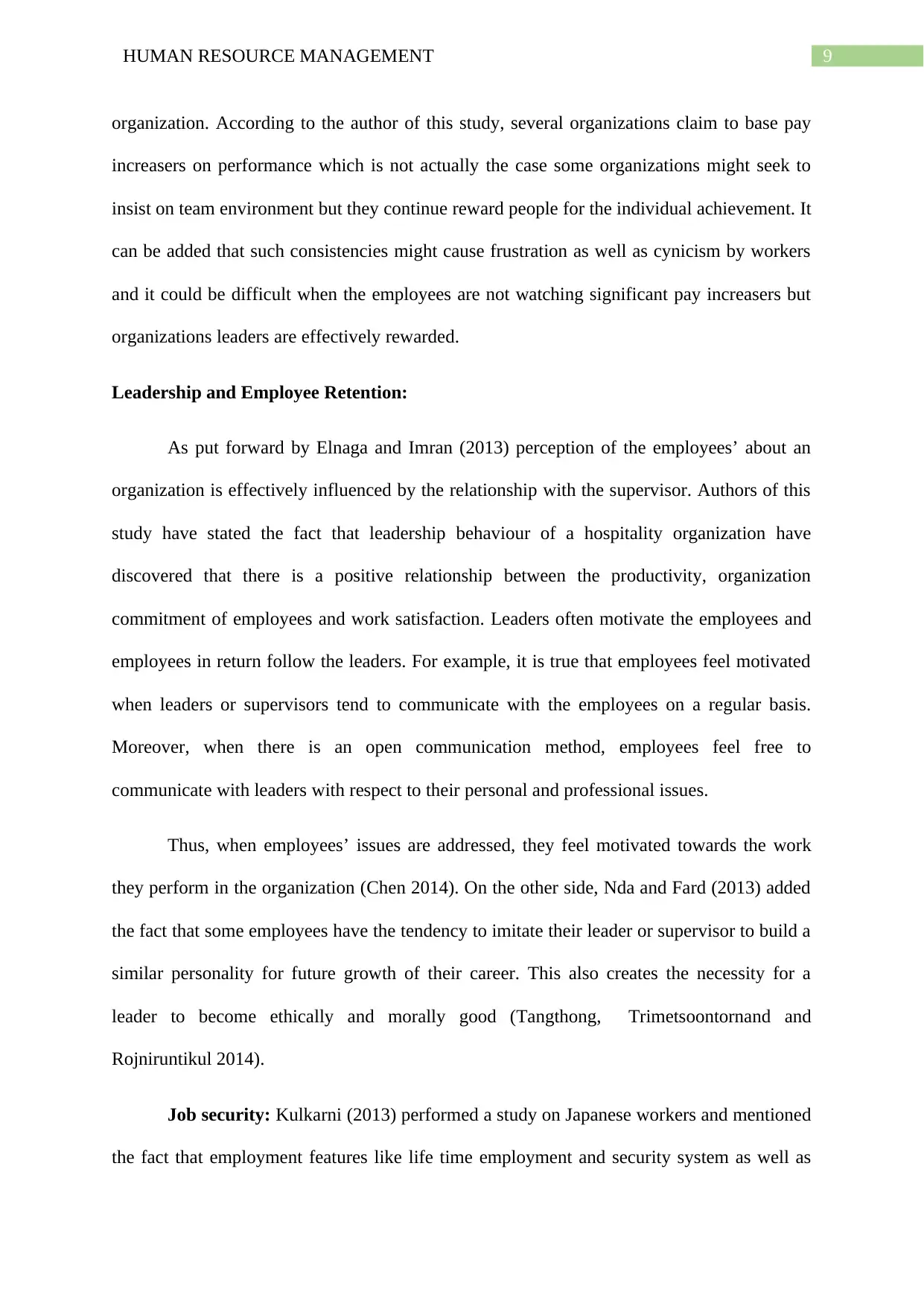
9HUMAN RESOURCE MANAGEMENT
organization. According to the author of this study, several organizations claim to base pay
increasers on performance which is not actually the case some organizations might seek to
insist on team environment but they continue reward people for the individual achievement. It
can be added that such consistencies might cause frustration as well as cynicism by workers
and it could be difficult when the employees are not watching significant pay increasers but
organizations leaders are effectively rewarded.
Leadership and Employee Retention:
As put forward by Elnaga and Imran (2013) perception of the employees’ about an
organization is effectively influenced by the relationship with the supervisor. Authors of this
study have stated the fact that leadership behaviour of a hospitality organization have
discovered that there is a positive relationship between the productivity, organization
commitment of employees and work satisfaction. Leaders often motivate the employees and
employees in return follow the leaders. For example, it is true that employees feel motivated
when leaders or supervisors tend to communicate with the employees on a regular basis.
Moreover, when there is an open communication method, employees feel free to
communicate with leaders with respect to their personal and professional issues.
Thus, when employees’ issues are addressed, they feel motivated towards the work
they perform in the organization (Chen 2014). On the other side, Nda and Fard (2013) added
the fact that some employees have the tendency to imitate their leader or supervisor to build a
similar personality for future growth of their career. This also creates the necessity for a
leader to become ethically and morally good (Tangthong, Trimetsoontornand and
Rojniruntikul 2014).
Job security: Kulkarni (2013) performed a study on Japanese workers and mentioned
the fact that employment features like life time employment and security system as well as
organization. According to the author of this study, several organizations claim to base pay
increasers on performance which is not actually the case some organizations might seek to
insist on team environment but they continue reward people for the individual achievement. It
can be added that such consistencies might cause frustration as well as cynicism by workers
and it could be difficult when the employees are not watching significant pay increasers but
organizations leaders are effectively rewarded.
Leadership and Employee Retention:
As put forward by Elnaga and Imran (2013) perception of the employees’ about an
organization is effectively influenced by the relationship with the supervisor. Authors of this
study have stated the fact that leadership behaviour of a hospitality organization have
discovered that there is a positive relationship between the productivity, organization
commitment of employees and work satisfaction. Leaders often motivate the employees and
employees in return follow the leaders. For example, it is true that employees feel motivated
when leaders or supervisors tend to communicate with the employees on a regular basis.
Moreover, when there is an open communication method, employees feel free to
communicate with leaders with respect to their personal and professional issues.
Thus, when employees’ issues are addressed, they feel motivated towards the work
they perform in the organization (Chen 2014). On the other side, Nda and Fard (2013) added
the fact that some employees have the tendency to imitate their leader or supervisor to build a
similar personality for future growth of their career. This also creates the necessity for a
leader to become ethically and morally good (Tangthong, Trimetsoontornand and
Rojniruntikul 2014).
Job security: Kulkarni (2013) performed a study on Japanese workers and mentioned
the fact that employment features like life time employment and security system as well as
Paraphrase This Document
Need a fresh take? Get an instant paraphrase of this document with our AI Paraphraser
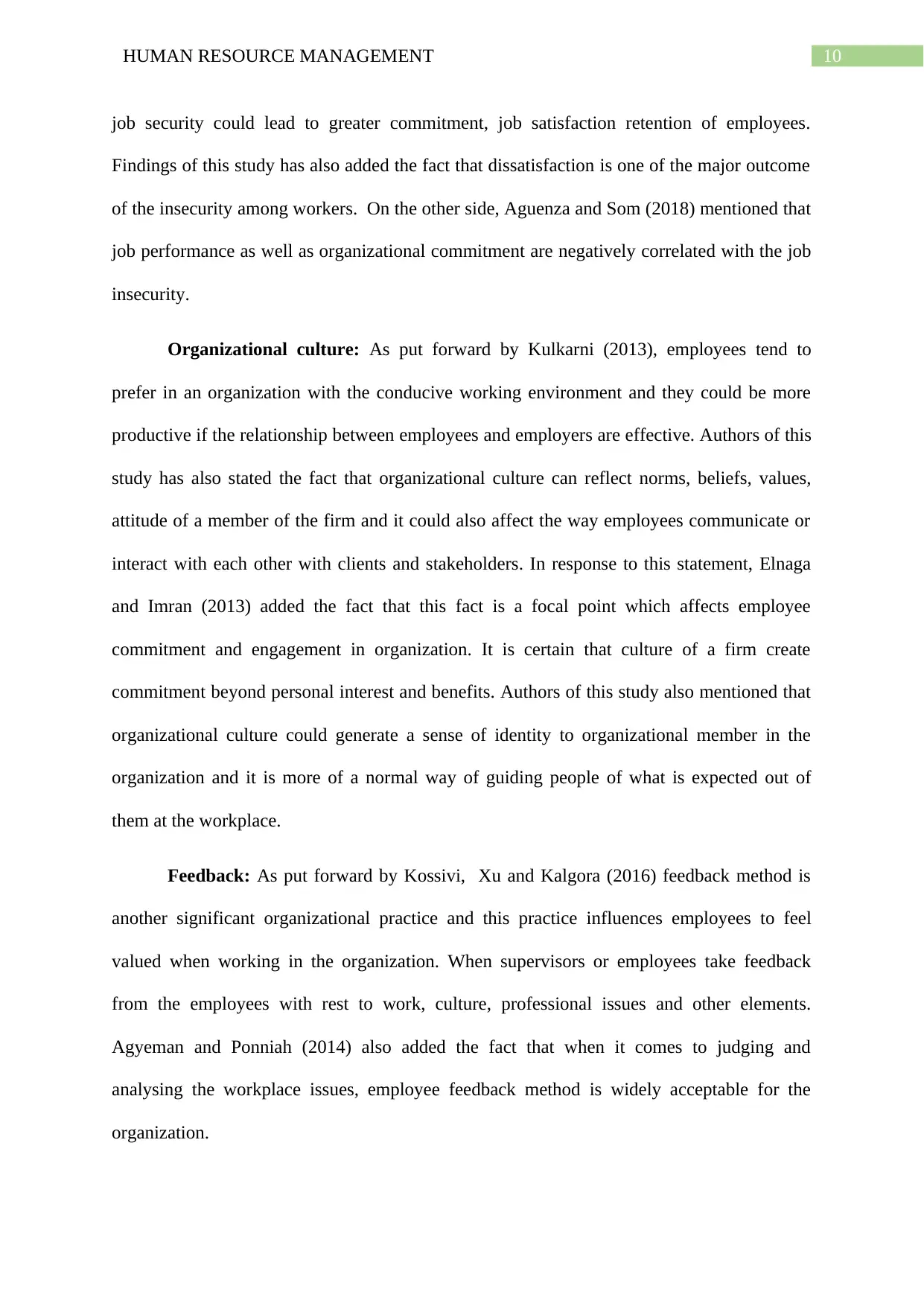
10HUMAN RESOURCE MANAGEMENT
job security could lead to greater commitment, job satisfaction retention of employees.
Findings of this study has also added the fact that dissatisfaction is one of the major outcome
of the insecurity among workers. On the other side, Aguenza and Som (2018) mentioned that
job performance as well as organizational commitment are negatively correlated with the job
insecurity.
Organizational culture: As put forward by Kulkarni (2013), employees tend to
prefer in an organization with the conducive working environment and they could be more
productive if the relationship between employees and employers are effective. Authors of this
study has also stated the fact that organizational culture can reflect norms, beliefs, values,
attitude of a member of the firm and it could also affect the way employees communicate or
interact with each other with clients and stakeholders. In response to this statement, Elnaga
and Imran (2013) added the fact that this fact is a focal point which affects employee
commitment and engagement in organization. It is certain that culture of a firm create
commitment beyond personal interest and benefits. Authors of this study also mentioned that
organizational culture could generate a sense of identity to organizational member in the
organization and it is more of a normal way of guiding people of what is expected out of
them at the workplace.
Feedback: As put forward by Kossivi, Xu and Kalgora (2016) feedback method is
another significant organizational practice and this practice influences employees to feel
valued when working in the organization. When supervisors or employees take feedback
from the employees with rest to work, culture, professional issues and other elements.
Agyeman and Ponniah (2014) also added the fact that when it comes to judging and
analysing the workplace issues, employee feedback method is widely acceptable for the
organization.
job security could lead to greater commitment, job satisfaction retention of employees.
Findings of this study has also added the fact that dissatisfaction is one of the major outcome
of the insecurity among workers. On the other side, Aguenza and Som (2018) mentioned that
job performance as well as organizational commitment are negatively correlated with the job
insecurity.
Organizational culture: As put forward by Kulkarni (2013), employees tend to
prefer in an organization with the conducive working environment and they could be more
productive if the relationship between employees and employers are effective. Authors of this
study has also stated the fact that organizational culture can reflect norms, beliefs, values,
attitude of a member of the firm and it could also affect the way employees communicate or
interact with each other with clients and stakeholders. In response to this statement, Elnaga
and Imran (2013) added the fact that this fact is a focal point which affects employee
commitment and engagement in organization. It is certain that culture of a firm create
commitment beyond personal interest and benefits. Authors of this study also mentioned that
organizational culture could generate a sense of identity to organizational member in the
organization and it is more of a normal way of guiding people of what is expected out of
them at the workplace.
Feedback: As put forward by Kossivi, Xu and Kalgora (2016) feedback method is
another significant organizational practice and this practice influences employees to feel
valued when working in the organization. When supervisors or employees take feedback
from the employees with rest to work, culture, professional issues and other elements.
Agyeman and Ponniah (2014) also added the fact that when it comes to judging and
analysing the workplace issues, employee feedback method is widely acceptable for the
organization.
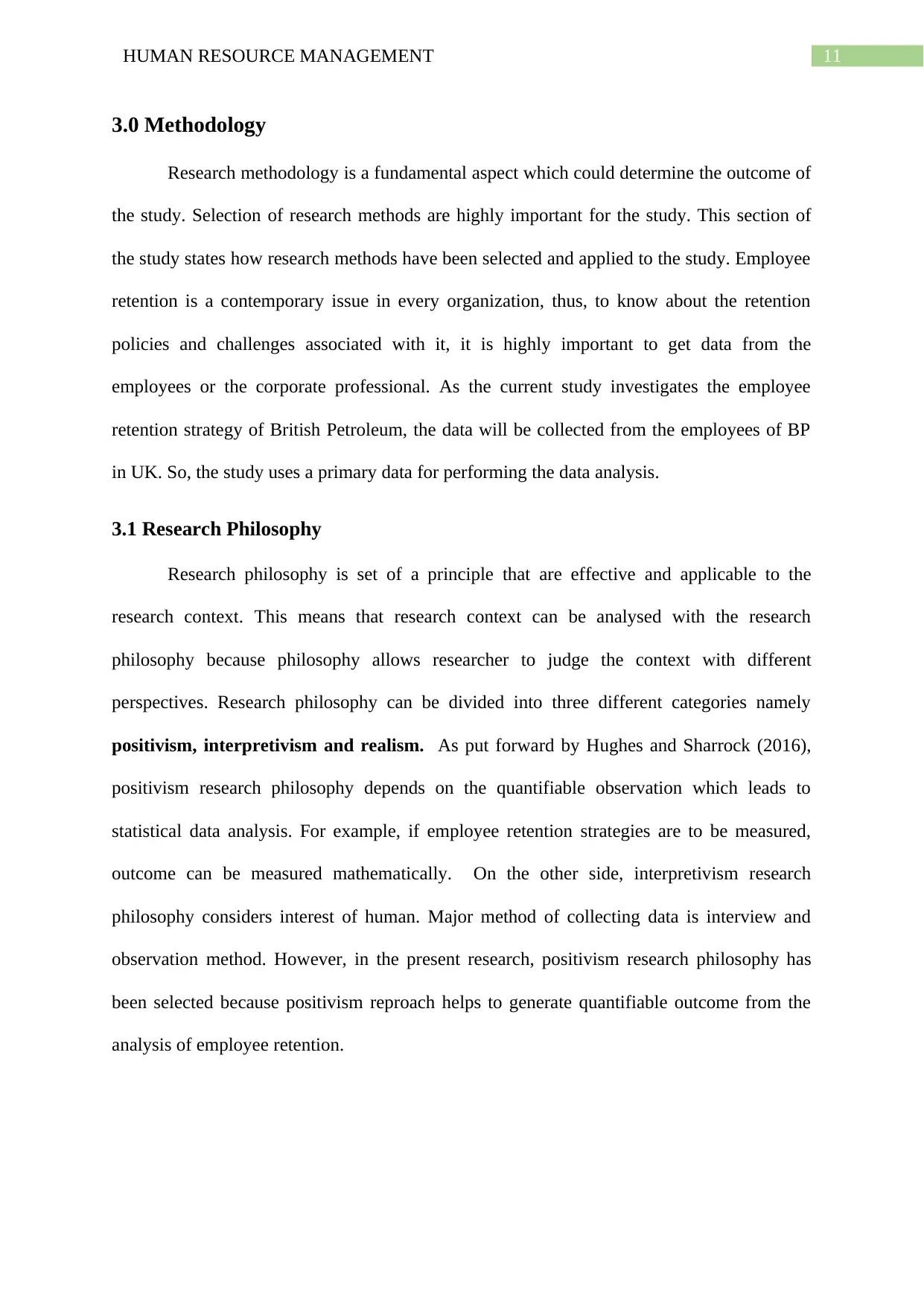
11HUMAN RESOURCE MANAGEMENT
3.0 Methodology
Research methodology is a fundamental aspect which could determine the outcome of
the study. Selection of research methods are highly important for the study. This section of
the study states how research methods have been selected and applied to the study. Employee
retention is a contemporary issue in every organization, thus, to know about the retention
policies and challenges associated with it, it is highly important to get data from the
employees or the corporate professional. As the current study investigates the employee
retention strategy of British Petroleum, the data will be collected from the employees of BP
in UK. So, the study uses a primary data for performing the data analysis.
3.1 Research Philosophy
Research philosophy is set of a principle that are effective and applicable to the
research context. This means that research context can be analysed with the research
philosophy because philosophy allows researcher to judge the context with different
perspectives. Research philosophy can be divided into three different categories namely
positivism, interpretivism and realism. As put forward by Hughes and Sharrock (2016),
positivism research philosophy depends on the quantifiable observation which leads to
statistical data analysis. For example, if employee retention strategies are to be measured,
outcome can be measured mathematically. On the other side, interpretivism research
philosophy considers interest of human. Major method of collecting data is interview and
observation method. However, in the present research, positivism research philosophy has
been selected because positivism reproach helps to generate quantifiable outcome from the
analysis of employee retention.
3.0 Methodology
Research methodology is a fundamental aspect which could determine the outcome of
the study. Selection of research methods are highly important for the study. This section of
the study states how research methods have been selected and applied to the study. Employee
retention is a contemporary issue in every organization, thus, to know about the retention
policies and challenges associated with it, it is highly important to get data from the
employees or the corporate professional. As the current study investigates the employee
retention strategy of British Petroleum, the data will be collected from the employees of BP
in UK. So, the study uses a primary data for performing the data analysis.
3.1 Research Philosophy
Research philosophy is set of a principle that are effective and applicable to the
research context. This means that research context can be analysed with the research
philosophy because philosophy allows researcher to judge the context with different
perspectives. Research philosophy can be divided into three different categories namely
positivism, interpretivism and realism. As put forward by Hughes and Sharrock (2016),
positivism research philosophy depends on the quantifiable observation which leads to
statistical data analysis. For example, if employee retention strategies are to be measured,
outcome can be measured mathematically. On the other side, interpretivism research
philosophy considers interest of human. Major method of collecting data is interview and
observation method. However, in the present research, positivism research philosophy has
been selected because positivism reproach helps to generate quantifiable outcome from the
analysis of employee retention.
⊘ This is a preview!⊘
Do you want full access?
Subscribe today to unlock all pages.

Trusted by 1+ million students worldwide
1 out of 42
Related Documents
Your All-in-One AI-Powered Toolkit for Academic Success.
+13062052269
info@desklib.com
Available 24*7 on WhatsApp / Email
![[object Object]](/_next/static/media/star-bottom.7253800d.svg)
Unlock your academic potential
Copyright © 2020–2025 A2Z Services. All Rights Reserved. Developed and managed by ZUCOL.





